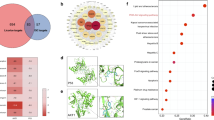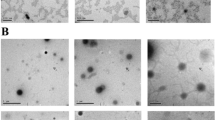Abstract
Peritoneal dialysis (PD) is the mainstay of treatment for renal failure replacement therapy. Although PD has greatly improved the quality of life of end-stage renal disease (ESRD) patients, long-term PD can lead to ultrafiltration failure, which in turn causes peritoneal fibrosis (PF). Silymarin (SM) is a polyphenolic flavonoid isolated from the milk thistle (Silybum marianum) species that has a variety of pharmacological actions, including antioxidant, anti-inflammatory, antiviral, and anti-fibrotic pharmacological activities. However, the effect of SM on PF and its potential mechanisms have not been clarified. The aim of this study was to investigate the preventive effect of SM on PF in vitro and in vivo as well as elucidate the underlying mechanisms. We established PF mouse models and human pleural mesothelial cell fibrosis in vitro by intraperitoneal injection of high-glucose peritoneal dialysis solution (PDS) or transforming growth factor-β1 (TGF-β1), and evaluated the effect of SM on peritoneal fibrosis in vivo and in vitro. We found that SM alleviated peritoneal dysfunction. Meanwhile, SM inhibited the expression of fibrotic markers (TGF-β1, collagen I, fibronectin) and restored the expression of E-cadherin, BMP-7 in PF mice and TGF-β1-treated Met-5A cells. Furthermore, SM markedly down-regulated the expression of TGF-β1, p-Smad2, and p-Smad3 and up-regulated the expression of smad7. In conclusion, these findings suggested that SM may be an efficient and novel therapy for the prevention of PF through inhibition of TGF-β/Smad signaling.










Similar content being viewed by others
Data availability
The datasets generated during and/or analyzed during the current study are not publicly available due to reasons way date are not public, but are available from the corresponding author on reasonable request.
The study protocol and animal handling procedures were approved by the Experimental Animal Ethics Committee of Nanjing Hospital Affiliated to Nanjing Medical University (Ethical approval number: DWSY-22045176).
References
Anwar S, Madkor HR, Ahmed N, Wagih ME (2018) In vivo anticlastogenic effect of silymarin from milk thistle Silybum marianum L. Indian J Pharmacol 50:108–115. https://doi.org/10.4103/ijp.IJP_660_16
Balzer MS (2020) Molecular pathways in peritoneal fibrosis. Cell Signal 75:109778. https://doi.org/10.1016/j.cellsig.2020.109778
Chambers CS, Holečková V, Petrásková L, Biedermann D, Valentová K, Buchta M, Křen V (2017) The silymarin composition… and why does it matter??? Food Res Int 100:339–353. https://doi.org/10.1016/j.foodres.2017.07.017
Chen IS, Chen YC, Chou CH, Chuang RF, Sheen LY, Chiu CH (2012) Hepatoprotection of silymarin against thioacetamide-induced chronic liver fibrosis. J Sci Food Agric 92:1441–1447. https://doi.org/10.1002/jsfa.4723
Chen Y, Chen L, Yang T (2021) Silymarin nanoliposomes attenuate renal injury on diabetic nephropathy rats via co-suppressing TGF-β/Smad and JAK2/STAT3/SOCS1 pathway. Life Sci 271: 119197. https://doi.org/10.1016/j.lfs.2021.119197
Chen X, Yang Q, Bai W, Yao W, Liu L, Xing Y, Meng C, Qi P, Dang Y, Qi X (2022) Dapagliflozin attenuates myocardial fibrosis by inhibiting the TGF-β1/Smad signaling pathway in a normoglycemic rabbit model of chronic heart failure. Front Pharmacol 13: 873108. https://doi.org/10.3389/fphar.2022.873108
Clichici S, Olteanu D, Filip A, Nagy AL, Oros A, Mircea PA (2016) Beneficial effects of silymarin after the discontinuation of CCl4-induced liver fibrosis. J Med Food 19:789–797. https://doi.org/10.1089/jmf.2015.0104
Costalonga EC, de Freitas LJ, Aragone DDSP, Silva FMO, Noronha IL (2017) Anti-fibrotic effects of valproic acid in experimental peritoneal fibrosis. PLoS One 12: e0184302. https://doi.org/10.1371/journal.pone.0184302
Dou F, Ding Y, Wang C, Duan J, Wang W, Xu H, Zhao X, Wang J, Wen A (2020) Chrysophanol ameliorates renal interstitial fibrosis by inhibiting the TGF-β/Smad signaling pathway. Biochem Pharmacol 180: 114079. https://doi.org/10.1016/j.bcp.2020.114079
Gillessen A, Schmidt HH (2020) Silymarin as supportive treatment in liver diseases: a narrative review. Adv Ther 37:1279–1301. https://doi.org/10.1007/s12325-020-01251-y
Jiang N, Zhang Z, Shao X, Jing R, Wang C, Fang W, Mou S, Ni Z (2020) Blockade of thrombospondin-1 ameliorates high glucose-induced peritoneal fibrosis through downregulation of TGF-β1/Smad3 signaling pathway. J Cell Physiol 235:364–379. https://doi.org/10.1002/jcp.28976
Kaneko K, Hamada C, Tomino Y (2007) Peritoneal fibrosis intervention. Perit Dial Int 2:S82–S86
Kang H (2017) Role of MicroRNAs in TGF-β signaling pathway-mediated pulmonary fibrosis. Int J Mol Sci 18:2527. https://doi.org/10.3390/ijms18122527
Ko JW, Shin NR, Park SH, Lee IC, Ryu JM, Kim HJ, Cho YK, Kim JC, Shin IS (2017) Silibinin inhibits the fibrotic responses induced by cigarette smoke via suppression of TGF-β1/Smad 2/3 signaling. Food Chem Toxicol 106:424–429. https://doi.org/10.1016/j.fct.2017.06.016
Li Y, Wang L, Zhang Q, Tian L, Gan C, Liu H, Yin W, Ye T(2022) Blueberry juice attenuates pulmonary fibrosis via blocking the TGF-β1/Smad signaling pathway. Front Pharmacol 13:825915. https://doi.org/10.3389/fphar.2022.825915
Liu CH, Jassey A, Hsu HY, Lin LT (2020a) Antiviral activities of silymarin and derivatives. Molecules 24:1552. https://doi.org/10.3390/molecules24081552
Liu R, Wang Q, Ding Z, Zhang X, Li Y, Zang Y, Zhang G (2020b) Silibinin augments the antifibrotic effect of valsartan through inactivation of TGF-β1 signaling in kidney. Drug Des Devel Ther 14:603–611. https://doi.org/10.2147/DDDT.S224308
Mehrotra R, Devuyst O, Davies SJ, Johnson DW (2016) The current state of peritoneal dialysis. J Am Soc Nephrol 27:3238–3252. https://doi.org/10.1681/ASN.2016010112
Meng S, Yang F, Wang Y, Qin Y, Xian H, Che H, Wang L (2019) Silymarin ameliorates diabetic cardiomyopathy via inhibiting TGF-β1/Smad signaling. Cell Biol Int 43:65–72. https://doi.org/10.1002/cbin.11079
Nie J, Dou X, Hao W, Wang X, Peng W, Jia Z, Chen W, Li X, Luo N, Lan HY, Yu XQ (2007) Smad7 gene transfer inhibits peritoneal fibrosis. Kidney Int 72:1336–1344. https://doi.org/10.1038/sj.ki.5002533
Resende VQ, Reis-Goes KH, Finato AC, de Fátima A-D, Dos Santos AR, Perico J, Amorim BC, Venturini J (2022) Combined silymarin and cotrimoxazole therapy attenuates pulmonary fibrosis in experimental paracoccidioidomycosis. J Fungi (basel) 8:1010. https://doi.org/10.3390/jof8101010
Shi Y, Hu Y, Wang Y, Ma X, Tang L, Tao M, Qiu A, Zhuang S, Liu N (2021) Blockade of autophagy prevents the development and progression of peritoneal fibrosis. Front Pharmacol 12: 724141. https://doi.org/10.3389/fphar.2021.724141
Strippoli R, Moreno-Vicente R, Battistelli C, Cicchini C, Noce V, Amicone L, Marchetti A, Del Pozo MA, Tripodi M (2016) Molecular mechanisms underlying peritoneal EMT and fibrosis. Stem Cells Int 2016:3543678. https://doi.org/10.1155/2016/3543678
Su W, Wang H, Feng Z, Sun J (2020) Nitro-oleic acid inhibits the high glucose-induced epithelial-mesenchymal transition in peritoneal mesothelial cells and attenuates peritoneal fibrosis. Am J Physiol Renal Physiol 318:F457–F467. https://doi.org/10.1152/ajprenal.00425.2019
Sun Y, Zhu F, Yu X, Nie J, Huang F, Li X, Luo N, Lan HY, Wang Y (2009) Treatment of established peritoneal fibrosis by gene transfer of Smad7 in a rat model of peritoneal dialysis. Am J Nephrol 30:84–94. https://doi.org/10.1159/000203362
Terri M, Trionfetti F, Montaldo C, Cordani M, Tripodi M, Lopez-Cabrera M, Strippoli R (2021) Mechanisms of peritoneal fibrosis: focus on immune cells-peritoneal stroma interactions. Front Immunol 12: 607204. https://doi.org/10.3389/fimmu.2021.607204
Tighe SP, Akhtar D, Iqbal U, Ahmed A (2020a) Chronic liver disease and silymarin: a biochemical and clinical review. J Clin Transl Hepatol 8: 454–458. https://doi.org/10.14218/JCTH.2020.00012
Tighe SP, Akhtar D, Iqbal U, Ahmed A (2020b) Chronic liver disease and silymarin: a biochemical and clinical review. J Clin Transl Hepatol 8:454–458. https://doi.org/10.14218/JCTH.2020.00012
Tomino Y (2012) Mechanisms and interventions in peritoneal fibrosis. Clin Exp Nephrol 16:109–114
Trappoliere M, Caligiuri A, Schmid M, Bertolani C, Failli P, Vizzutti F, Novo E, di Manzano C, Marra F, Loguercio C, Pinzani M (2009) Silybin, a component of sylimarin, exerts anti-inflammatory and anti-fibrogenic effects on human hepatic stellate cells. J Hepatol 50:1102–1111. https://doi.org/10.1016/j.jhep.2009.02.023
Tzavlaki K, Moustakas A (2020) TGF-β Signaling Biomolecules 10:487. https://doi.org/10.1007/s10157-011-0533-y
Tzeng JI, Chen MF, Chung HH, Cheng JT (2013) Silymarin decreases connective tissue growth factor to improve liver fibrosis in rats treated with carbon tetrachloride. Phytother Res 27:1023–1028. https://doi.org/10.1002/ptr.4829
Ullah H, Khan H (2018) Anti-Parkinson potential of silymarin: mechanistic insight and therapeutic standing. Front Pharmacol 9:422. https://doi.org/10.3389/fphar.2018.00422
Wadhwa K, Pahwa R, Kumar M, Kumar S, Sharma PC, Singh G, Verma R, Mittal V, Singh I, Kaushik D, Jeandet P (2022) Mechanistic insights into the pharmacological significance of silymarin. Molecules 27:5327. https://doi.org/10.3390/molecules27165327
Wu J, Xing C, Zhang L, Mao H, Chen X, Liang M, Wang F, Ren H, Cui H, Jiang A, Wang Z, Zou M, Ji Y (2018) Autophagy promotes fibrosis and apoptosis in the peritoneum during long-term peritoneal dialysis. J Cell Mol Med 22:1190–1201. https://doi.org/10.1111/jcmm.13393
Wu J, Huang C, Kan GX, Han Y, Zhang X, Yang J (2021) Silymarin regulates TGF-β1/Smad3 signaling pathway and improves renal tubular interstitial fibrosis caused by obstructive nephropathy. Curr Top Nutraceut R 19:508–513
Xie Y, Zhang D, Zhang J, Yuan J (2019) Metabolism, transport and drug-drug interactions of silymarin. Molecules 24:3693. https://doi.org/10.3390/molecules24203693
Yu JW, Duan WJ, Huang XR, Meng XM, Yu XQ, Lan HY (2014) MicroRNA-29b inhibits peritoneal fibrosis in a mouse model of peritoneal dialysis.Lab Invest 94: 978–90. https://doi.org/10.1038/labinvest.2014.91
Zhang Y, Huang Q, Chen Y, Peng X, Wang Y, Li S, Wu J, Luo C, Gong W, Yin B, Xiao J, Zhou W, Peng F, Long H (2020) Parthenolide, an NF-κB inhibitor, alleviates peritoneal fibrosis by suppressing the TGF-β/Smad pathway. Int Immunopharmacol 78: 106064. https://doi.org/10.1016/j.intimp.2019.106064
Zhao F, Shi D, Li T, Li L, Zhao M (2015) Silymarin attenuates paraquat-induced lung injury via Nrf2-mediated pathway in vivo and in vitro. Clin Exp Pharmacol Physiol 42:988–998. https://doi.org/10.1111/1440-1681.12448
Zhao XA, Chen GM, Liu Y, Chen YX, Wu HY, Chen J, Xiong YL, Tian C, Wang GY, Jia B, Xia J, Wang J, Yan XM, Zhang ZP, Huang R, Wu C (2017) Inhibitory effect of silymarin on CCl4-induced liver fibrosis by reducing Ly6Chi monocytes infiltration. Int J Clin Exp Pathol 10:11941–11951
Zhou Q, Bajo MA, Del Peso G, Yu X, Selgas R (2016) Preventing peritoneal membrane fibrosis in peritoneal dialysis patients. Kidney Int 90:515–524. https://doi.org/10.1016/j.kint.2016.03.040
Funding
This work was supported by the National Natural Science Foundation of China (No.81903684); the Hospital Pharmacy Research Foundation of Changzhou Siyao Hospital and Nanjing Pharmaceutical Association (2019YX019); the Fundamental Research Funds for the Central Universities (021414380498); Foundation of Nanjing Medical Center for Clinical Pharmacy.
Author information
Authors and Affiliations
Contributions
Yingwen Bai conducted the experiments and wrote the manuscript. Lulu Wang conceived and designed the study and helped conduct it. TingYang and Lingyun Wang conducted statistical analysis and data analysis. Weihong Ge edited and revised the manuscript, revised and approved the final manuscript. All authors contributed to manuscript revision, read, and approved the submitted version. The authors confirm that all data were generated in-house and that no paper mill was used.
Corresponding author
Ethics declarations
Competing interests
The authors declare no competing interests.
Additional information
Publisher's note
Springer Nature remains neutral with regard to jurisdictional claims in published maps and institutional affiliations.
Rights and permissions
Springer Nature or its licensor (e.g. a society or other partner) holds exclusive rights to this article under a publishing agreement with the author(s) or other rightsholder(s); author self-archiving of the accepted manuscript version of this article is solely governed by the terms of such publishing agreement and applicable law.
About this article
Cite this article
Bai, Y., Wang, L., TingYang et al. Silymarin ameliorates peritoneal fibrosis by inhibiting the TGF-β/Smad signaling pathway. Naunyn-Schmiedeberg's Arch Pharmacol 396, 2379–2391 (2023). https://doi.org/10.1007/s00210-023-02450-4
Received:
Accepted:
Published:
Issue Date:
DOI: https://doi.org/10.1007/s00210-023-02450-4




